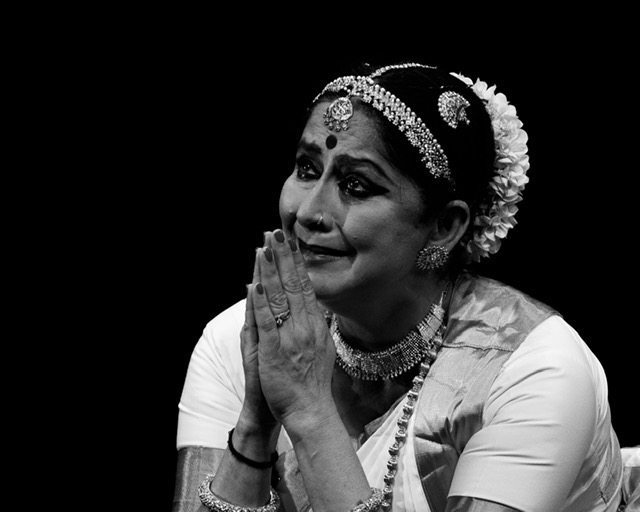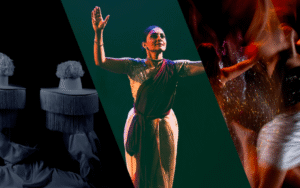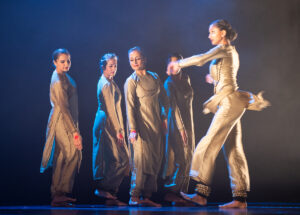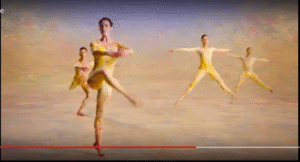Nrithya Arpanam
Mohiniattam performance by Shalini Shivashankar
18th November 2022
Bhavan, London
Reviewed by Annapoorna Kuppuswamy
Photos: Sujith Kumar
In the premier venue for classical Indian arts, the Bhavan in West London, as the autumn chill was setting in, the gathering of connoisseurs was treated to a presentation of a full traditional repertoire of mohiniyattam by Shalini Shivashankar, an excellent artist accompanied by a first class live orchestra. Rarely does one have the opportunity to witness a whole evening of mohiniyattam, a sensuous art form defined by its fluidity and sedate pace. This presentation enabled one to savour and absorb the finer details, as a classical performance should.
The evening opened with a Ganesha saptam, a traditional invocatory piece, in Ragam Neelambari, followed by a chollukattu, an introductory item with both pure dance and expressive sections, in Ragamalika. Shalini instantly conveyed the very essence of mohiniyattam with perfectly executed charis; deep rounded moves, arms and body always following a curved trajectory and never striking an angular pose. The Ragam Neelambari, commonly associated with lullabies, perfectly accentuated the seamless steps that depicted the dancing Ganesha. The chollukattu was an interesting piece where the chollus (rhythmic syllables) were sung rather than recited, with a refrain on Gowri and Shankara punctuating this versatile number; and curiously for an opening piece, it finished off with a mangalam in madhyamavathi (a popular ragam for concluding pieces).
The highlight of the evening was a varnam describing the plight of the heroine who is separated from Madhava, Suma Saayaka in Ragam Karnataka Kapi. This classic piece was handled expertly by Shalini, drawing the audience into a world of painful separation as the sakhi describes a suffering nayika, struck by cupid’s arrows, unable to draw pleasure from the beautiful moon or the blissful music from the veena. Not only was the abhinaya exquisite, but the pure dance sequences were delivered with aplomb with perfectly executed valayams (a circular movement of the upper body while the lower body maintains a half-seated posture), innovative combination of chuvadus (step sequences), and well-positioned mandalas. The second half of the varnam was interestingly the same pace as the first half and could have benefited from some gathi bedha (variation in speed). The Ragamalika Swara (musical notes from different ragas) sequence to finish the varnam added a fitting flourish to the varnam.
The chosen padam for the evening was from the kathakali repertoire, Ajitha hare in Sriragam describing the meeting between Krishna and his childhood friend Sudama. Although a very popular story in Hindu mythology, it is rarely performed in dance. Shalini perfectly created the mood of someone aware of their own humble position, as Sudhama walked towards the palatial grounds of Krishna’s abode. Sudhama’s hesitation, Krishna’s rapturous welcome and the joyous reunion were beautifully performed. The enactment of Geetha Upadesham (the divine instruction), with Krishna commandeering Arjuna’s chariot in the battlefield, the fear and sadness of Arjuna at the sight of his opponents who were his family, Krishna’s words of wisdom and the magnificent Vishva Roopam (the universal form) as seen by Arjuna, were executed in such a way that the audience had an immersive experience of Kurukshetra, the holy battlefield.

The evening concluded with a thillana in Ragam Shankarabharanam and the Rama Saptam. In an age of high-speed athletic thillanas, the pace of this thillana was a definite outlier, with both the song and dance competing to capture the essence of slowness. Voluptuous mei adavus (repetitive step sequences performed in variable speeds at the beginning of a thillana) gave way to a theermanam which then beautifully blended into the description of Sundareshan adorned by grand serpents. The lyrics were followed by several swara (musical note) sequences much like the popular Shankarabharanam thana varnam. The Rama saptam (an item with both expressive and pure dance elements, with the word ‘saptam’ translating into seven stanzas) was a fitting finale to the evening, with the telling of the story of Rama. The birth of a prince, the breaking of the bow to win the hand of Sita, the anguished exile and the capture of Sita leading to the final battle with Ravana, were all captured within this epic rendition of the saptam. Shalini excels in her story telling skills through abhinaya, and chose a wide-ranging repertoire of items that well-suited her abilities. While story telling is one aspect of abhinaya, emotional exploration was limited to the bakthi bhava (devotion) and depiction of a virahothkaditha nayika (one who is distressed in separation) in the varnam. It would be wonderful to see Shalini explore a fuller range of emotional states in her abhinaya, providing even greater depth to her already excellent performance.
The performance would not have been a grand success without the brilliant orchestral support. With Smitha Rajan, an expert in mohiniyattam on the nattuvangam ably leading the team, heart-felt rendition of the music by Vamshi Krishna Vishnu Das, soulful flute by Vijay Venkat, flawless percussion by Prathap and innovative rhythm embellishments by Chidambaranathan, the evening was a well-balanced, satisfying classical performance.




